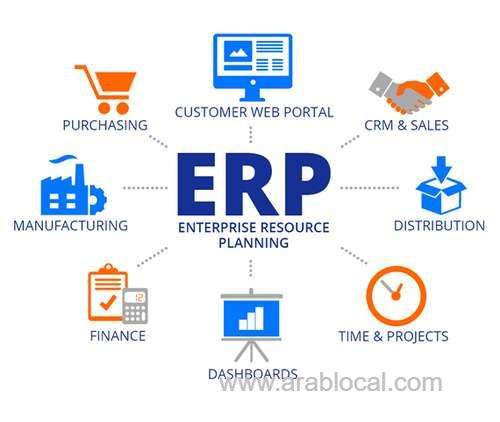Enterprise resource planning software has become popular among businesses that want to streamline and centralize their operations. However, to get the most out of your ERP software, you’d need your employees to use it to its full potential. In addition, if you have never used an ERP system before, it may become challenging to understand how it works.
In this article, we will explain what ERP is and how to use ERP software to enhance your operations. We will also discuss how you can automate tedious processes to boost productivity and eliminate manual errors.
What is ERP?
ERP (Enterprise Resource Planning) software is a business application that helps you combine all your processes. From human resources and finances to customers and supply chain management, you can manage everything from one place. This gives you a birds-eye view of your business performance and enables you to enhance it.
The key features of ERP systems include the following:
HR & Payroll
Customer relationship management (CRM)
Financials and accounting
Inventory and warehouse management
Project costing management
Sales management
Supply chain management
Analytics and reports
You can choose an industry-specific solution to ensure it solves business challenges in your industry. For instance, trading companies in UAE can choose https://firstbit.ae/distribution/ to manage multiple sales channels simultaneously. As the best distribution ERP software, FirstBIT eliminates communication gaps across branches and allows you to create various price lists (for different customers). Based in Dubai, FirstBIT also makes it easier to comply with UAE’s laws and regulations, including VAT law.
Benefits of ERP for Businesses
The competitive nature of today’s markets means business owners must seize every opportunity to outperform their rivals. ERP enables businesses to plan precisely, ease access to management systems, and improve customer service.
1- Single Source of Truth
Better understand your business’s financial performance, customer satisfaction, and orders from one place. Prebuilt analytics can help measure KPIs in real-time, including debt-to-equity ratio, inventory turnover, and net working capital, to name a few. In addition, since everything is consolidated into a single system, it eliminates duplicate data and confusion.
2- Better Customer Service
ERP accumulates all necessary information on sales and customers, making it easier for your employees to personalize the customer experience. They can reduce the request resolution time by analyzing customers’ past queries and behavior patterns. Faster access to customer histories with enhanced accuracy enables you to make more accurate demand predictions and identify upsell opportunities.
3- Improved Management Performance
ERP solutions automate data handling and integrate all the departments within the company. As a result, stakeholders can get a comprehensive view of how each department and the business is performing. It makes it easier to identify bottlenecks across processes so they can take corrective action before it’s too late.
4- Improved Collaboration and Coordination
The unified system allows employees to access real-time information and share real-time data from anywhere. It reduces communication delays across departments, improving efficiency and productivity. Many ERP systems also come with an inbuilt messenger to capture feedback and minimize interactions on emails.
5- Reduced Operational Costs
Thanks to reduced paperwork and optimization of day-to-day operations, businesses can cut costs on administrative needs. Besides, it makes resource planning easier and more efficient by using historical data to predict requirements for each project. This reduces costs around inventory, logistics, and supply chain. In addition, you can track estimates vs. actuals throughout the project to ensure profitability.
6- Better Cash Flow Management
An ERP system provides better insight into your cash position. It lets you monitor current and future cash flow. You can also create invoices faster to improve the receivable turnaround time. Fast payments mean more cash on hand for the business for future operations.
How to Use ERP Software?
When utilized properly, an ERP system can boost efficiency, reduce errors, and improve your business’s overall performance. Here’s how to use ERP software to get the most out of your investment.
1- Review Your Existing Processes
Analyzing your current business processes is critical to identify what you can improve. It will also help you determine the areas of businesses that need transformation to become more efficient and cost-effective.
Begin by defining high-cost areas and tasks with more manual errors. Also, document the key business challenges you’d want to address with the system. This will act as a foundation for your ERP implementation and customization.
2- Customize Your ERP
Most ERP solutions come with out-of-the-box features to meet the varying needs of businesses. And if you choose an industry-specific ERP, you might not need to customize it. However, if there are specific processes that it doesn’t currently support, you can add them with the help of your vendor or third-party ERP consultants.
Some customization options you can expect include concealing unnecessary fields, changing the look and feel of the dashboard, adding critical KPIs, and generating locally compliant reports.
3- Feed Quality Data to the System
Your ERP system provides insights based on the data you feed. Since you have one integrated system for all business processes, stakeholders can analyze business performance and plan for improvement. Even a minor error could lead to wrong decisions.
Thus, you must ensure the data is up-to-date and accurate. Take time to create policies around data entry, including how to handle data versioning. If you’re in the implementation stage, clean your data (i.e., remove outdated and duplicated data) before migrating. It can save countless hours and ensure company standards are being upheld.
4- Automate Tedious Processes
ERP automation can help optimize your processes, increase productivity, and cut manual errors. Here are some tasks you can automate via your ERP.
Tracking employee expenses: Employees often bill companies for business expenses (travel, meals, stay, etc.). While these expenses are reviewed manually, you can automatically set rules to decline them over a certain threshold. You can also convert those costs into a visual model so human resources can understand it easily.
Payroll: A good ERP allows you to automate payroll processes in compliance with local laws. You can set rules to track leaves and overtime to automate payroll calculations. The system will then pay salaries accordingly.
Purchasing: Define what is low stock for you, and the ERP will place orders automatically as soon as you reach the threshold. You can also automate vendor and supplier payments to ensure they get paid on time.
Financial forecasting and planning: Budgeting and financial forecasting are critical for every business. Doing it manually is not only time-consuming but also prone to errors. On the other hand, an ERP system can use business intelligence to improve forecasting accuracy.
5- Train Your Employees
One of the best ways to ensure your employees use the ERP to its full potential is by training them from the early stages of implementation. Involve subject matter experts from each department, so they understand how the system can improve their day-to-day operations. They can also provide insights into the functionalities that could prove helpful.
As the implementation progresses, involve more employees so they know how to navigate the system from the first day. In addition, you can work with your vendor to document training sessions that elevate the knowledge of the software.
Since ERP systems are constantly evolving, you must also train your employees often. This will keep them updated with the latest features and changes in the software.
6- Integrate With Third-Party Applications
For ERP to centralize your processes and act as a single source of truth, you need to integrate it with all your third-party applications. Cloud ERP vendors typically offer out-of-the-box integrations with other systems. However, if you use an on-premise solution, you must develop APIs to connect third-party tools with your ERP. Additionally, create a plan to integrate tools that you might add later.
7- Generate Custom Reports
With a cloud-based ERP system, you can generate real-time reports to get a 360-degree view of your operations. It lets you customize the reports to track the metrics that are most important to you. If your ERP allows, you can analyze these reports with artificial intelligence and business intelligence to convert raw data into actionable insights. You can also automate report generation and receive them in your email per schedule. This helps save time while keeping you up to date with necessary information.
ERP lets you create reports for each project as well. You can visualize the project’s P&L, cost and revenue structure, and estimates vs. actuals. As a result, you can keep each project within the budget and take corrective action if necessary.
8- Leverage Mobile Apps
Modern ERP systems come with a mobile application that helps you manage your operations from your fingertips. These apps enhance the accessibility of your system and offer improved visibility of your workflows. In addition, your employees can use mobile apps to access critical information within minutes, irrespective of where they are. This is an easy and cost-effective way for everyone to stay up-to-date with all business processes.
Final Thoughts
An enterprise resource planning system can help businesses boost productivity, efficiency, and return on investment but only when used to its full potential. Reviewing your business processes and customizing the solution to meet your unique needs is the first step towards it. You must also train your employees regularly to help them use all its features. Last but not least, automate tedious processes to reduce errors and boost profitability.
Ready to maximize your ERP’s potential? Use the tips and tricks mentioned above to do so!
Total Words: 1583







